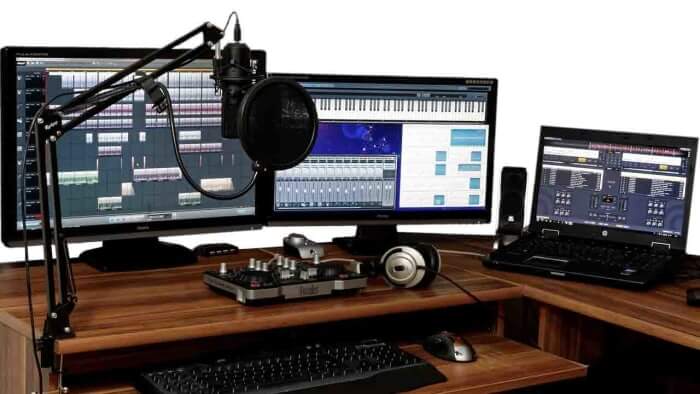Your master bus is the mixer channel where all of your sources sum together.
It’s the last stage in your DAW before your mix goes to your audio interface and out to your speakers.
It might sound easy, however, managing your master bus is vital for getting a great mix overall.
When you make poor decisions here, they will impact your entire mix.
So how should you treat your master bus? What processing should you use and which issues should you watch out for?
In this post, We will show you everything you should know about the master bus to get an ideal bounce of your mix.
Let’s get started.
What’s the master bus?
The master bus is the last stereo channel in your DAW’s mixer before your audio outputs to your speakers. It means every other track and aux return channel included in your mix is eventually routed right here. It’s typically known as the stereo bus, the 2-bus, or the mix bus.
The master bus represents the sum of all the tracks in your mix, however, it’s additionally a track with its own meters, inserts, and fader.
Some engineers use the grasp bus to add additional processing that impacts your entire mix.
Why is the master bus necessary?
The master bus is the closest representation of what your mix shall be like as a rendered stereo file.
This means it’s one of the most essential places to verify for qualities like output level and dynamics.
If something is wrong at the master bus, it’ll nearly certainly be a problem in the bounced file you send for mastering.
Problems that happen at the master bus are sometimes symptoms of larger mix issues that should be addressed for good results.
I’m mentioning basics such as loudness, headroom and gain staging.
However, there are more than just technical issues in terms of your mix bus.
Many producers depend on master bus processing to shape the overall tone of the mix.
It’s a strong technique. Master bus processing could make a really big effect because you are affecting every single track at once.
How to get healthy levels at your mix bus
Levels are the main technical problem that newbie and intermediate producers face with their master bus.
When you are simply getting began with music production you may not realize how quickly tracks could pile up when summed together at the mix bus.
If the output level of the mix bus is too high, it’ll cause harsh clipping if you export your mix.
One answer is to just pull down your master fader till the volume is at a healthy level.
This could help in a pinch, however, it isn’t the best answer for managing levels at the mix bus.
The real trick comes from great gain staging. This means maintaining your levels in check at every stage of your process—from tracking to mastering.
When you begin with plenty of space, there shall be much more room for the tracks to sum together before you must start dragging all of your faders down.
That space is known as headroom. Right here’s useful information on creating and maintaining it:
However, when you just want the basic version, right here is the rule of thumb: attempt not to let your peaks go above -9 dBFS on your meters and keep the body of the sound hovering around -18 dBFS.
When you stick to this rule you may see your mix has higher clarity and separation—even before you have changed anything else.
Master bus processing
Master bus processing means including effects to your 2-bus to shape the whole mix for a greater sound.
Lots of producers use mix bus processing as the last stage of mixing so as to add effects like EQ, compression, saturation, and stereo effects to the whole song.
However, master bus processing is usually considered controversial. It’s simple to do more harm than good if you apply effects to a whole mix.
You could simply go too far and suck the life out of a superbly good mix when you get too aggressive with your mix bus processing.
Actually, many engineers don’t bother utilizing effects on the stereo bus and prefer to leave all of the 2-bus processing to the mastering engineer.
When you are just getting began with compression and EQ or you do not have a clear idea of what you are trying to do, think about leaving mix bus processing out.
That mentioned, you should not be afraid to experiment with effects on your 2-bus if it helps you get nearer to the completed sound you want for your mix.
A great rule of thumb is to concentrate on processing that impacts the tonal balance and character of the mix and keep away from anything that changes the headroom and dynamics too much.
Master bus effects vs. Mastering
Master bus processing isn’t the same as mastering. It’s vital to know where to draw the line.
Mastering engineers use highly sophisticated techniques to turn headroom into the raw level your tracks should sound loud and punchy on streaming services.
Master bus processing is much more about gentle tweaks that assist improve the overall feel of the mix.
Does everything in your track sound a bit dull? In some cases, a nice gentle shelving increase on the whole track sounds higher than boosting each sound individually.
The different sounds do not gel together? Try 1-3 dB of subtle compression.
A safe method to think of mix processing is like a tiny sweetening impact that you may not even notice till you take it away.
Mixing your mix bus
Your mix bus is a crucial part of your signal flow in a DAW session.
When you neglect it you could make problems that impact your sound.
However, when you have made it via this text you will have a good place to start for treating your master bus correctly.

